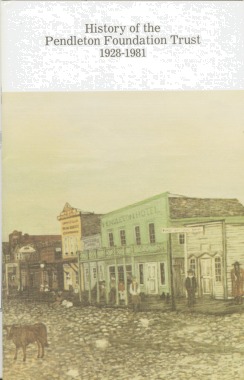The History of the Foundation, Part 2 of 3
Although the records of the Foundation’s early years were lost when the Stangier Brother’s Building burned in 1960, apparently there were enough contributions to make the fund a viable one. Undoubtedly the most significant bequest of this period was the the estate of Minnie E. Stillman, a long time Pendleton resident and community leader. The estate, received by the Foundation in 1936, was valued at over $42,000; an amount that greatly expanded the Foundation’s annual income. The income from this donation was used to help purchase such things as the bandstand at Pioneer Park, the base of the Til Taylor statue, a film projector for the senior high school and an oxygen tent for civic use. Minnie Stillman also donated her property on Byers Avenue with the request that it be made into a city park. A portion of her estate was used to purchase additional property for this project. The park finally began to take form in 1945, with the Foundation contributing $2,294 in 1946 and 1947 for development.
Through the years the Foundation has continued to provide money for improvements in Stillman Park, including $742 for stove covers in 1962 and 1968 and $5500 for tennis court lighting in 1978. The Foundation also purchased a marker for the park that reads as follows:
Dedicated in honor of Minnie E. Stillman, esteemed Pendleton pioneer who willed her estate to the people of Pendleton through the Pendleton Foundation Presented by the Pendleton Foundation 1961
During the 1940’s the bulk of the Foundation’s income went to the Pendleton Parks Commission. Of the approximately $13,700 distributed in that decade, nearly $10,900 went to the city for improvements in Pendleton parks. This trend continued in the 1950’s with $9,188 of the $15,400 distributed going to the Parks Commission. During the 1960’s, however, the percentage of Foundation income spent on city parks declined significantly; city parks received only $4,300 of the $20,400 distributed. This change can probably be explained easily enough – several decades of contributions enabled the city to purchase such things as drinking- fountains, playground equipment and wading pools, thus reducing the need for these items in later years.
In 1953, after twenty-five years of existence, the Foundation had accumulated over $47,000. There had been several generous contributions over the years, but there was a feeling that more could be given by those able to do so. The problem was exemplified in 1956 when not a cent was donated to the fund. The East Oregonian took note of this fact in an editorial of December 31 of that year. “If all the people in other cities who have looked upon the Pendleton Foundation as a model agency were told that not a single contribution was made to the organization in 1956,” the editorial stated, “they’d undoubtedly be shocked. We are. And it has set us to thinking that perhaps the general assumption that almost everybody in Pendleton knows about the Pendleton Foundation is false. Perhaps all who must share some responsibility for telling the Pendleton Foundation story are as guilty as those who had the means to give to the organization but did not.”
By the 1960’s, however, the contribution problem had diminished. Both trustee banks received hundreds of dollars in gifts for the Foundation.
Bequests were another major source of money for the Foundation. Some of the more substantial donations include C. P. Strain’s two gifts of $500 in 1948 and 1949, Edwin B. Aldrich’s bequest of $1000 in 1951, Effie Jean Frazier’s contribution of an estate worth $2,882 in 1952, Florence McCook’s gift of $3,000 in 1968 and Mary C. Allen’s bequest of $1,000 in 1971. Another large contribution was made in 1967, when the Pendleton Masonic Lodge released $3,818 from the estate of Sarah Thompson to the Foundation.
One means of contribution that became increasingly popular as the Foundation grew older was the special trust fund. These differed from the general fund in that those who established the fund specified how its income was to be spent. The Willetta W. Donert Memorial Fund is an example. Income from this fund was to be given to the Umatilla County Library for the purchase of books. The Kilkenny Fund, started by former Foundation Committee member and chairman John F. Kilkenny, was begun in 1955. Income was to be used by the Umatilla County Library to acquire manuscripts, books and records on the Oregon Territory as well as literature and history of Scotch and Irish origin. The Blue Mountain Community College Library was later named the recipient of this income. In the 1960’s the Jack Mulligan Memorial Fund was established, granting money to the County Library for books on American History, business, industry and biography.
History Books
History, 1928-1981, this first booklet on the history of the Foundation provides a review of how things started and the many grants given and the board members serving the community.
History, 1928-1986, the second installment modified the first booklet with the additional number of years
History, 1928-2002, entering a new century the Foundation updated its history and provided another listing of grants awarded and those serving on the board.
History, 1928 – 2018, celebrate the 90th year of the Pendleton Foundation Trust with this latest history of our board members, grants, and awards.




